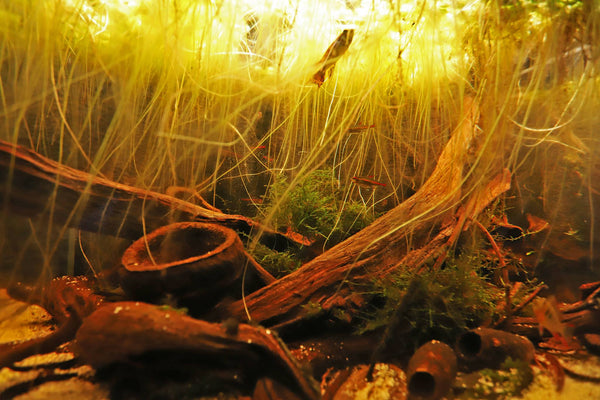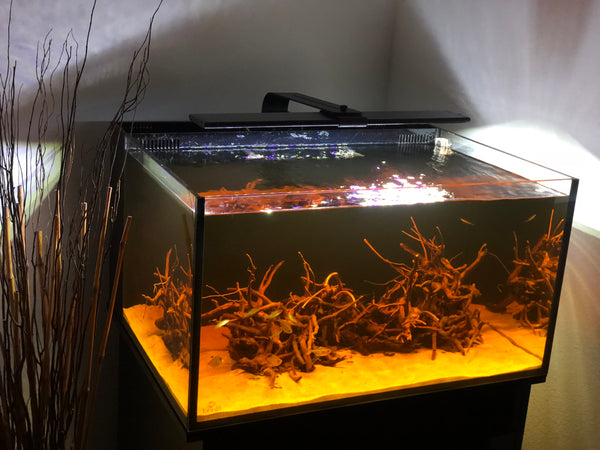- Continue Shopping
- Your Cart is Empty
Going through phases...
Most of you who read my meandering know that I spend a great deal of time focusing on, postulating about, and talking half-authoritatively about what I believe are the "evolutionary" phases and processes of botanical-style, blackwater/brackish aquariums. And I think it's because there is so much about them that differs significantly from the way a traditional aquarium establishes itself, matures, functions, and...evolves.
In general, our aquariums break in and mature, they sort of go through phases, don't they? I mean, sure- there is the brand spoken' new, "first water" phase, where the tank is essentially biologically at "near zero", with freshly-added sand, wood, etc. Likely, if you're playing with botanicals, you're adding them at this time, too. And then there is that initial phase, when the first intentionally added life forms (often simply bacteria from either some old filter media or one of those bacteria-in-a-bottle products) make their appearance. And of course, then we have the addition fishes!
And then it goes on from there.
Now, this idea of breaking in and cycling aquariums has been understood, analyzed, and studied since the dawn of modern aquarium keeping. Sure, there might be a dozen different variations of the sequences and details, but essentially it's all the same.
The phases that I am interested in, for the context of this discussion, are the ones which seem to occur long after an aquarium is cycled, "broken-in", and otherwise well-established- specifically in the context of this botanical-style aquarium we play with. These more mature phases are fascinating to me. These represent the aquarium at a point of ecological "maturity", when the biological processes that are so crucial are stable and well-established.
Without going in to any one of the dozens of aspects of a "mature" aquarium's definition, let's just say it's a system that you're not on edge about every day, and leave it at that!

Of course, an aquarium which utilizes botanicals as a good part of its hardscape follows a set of phases, too. And I've found that once a botanical-style aquarium (blackwater or brackish) hits that sort of "stable mode", it's just that- stable. You won't see wildly fluctuating pH leaves, nitrates, phosphates, etc. To a certain degree, the aquarium has achieved some sort of "biological equilibrium."

Now, one thing that's unique about the botanical-style approach is that we tend to accept the idea of decomposing materials accumulating in our systems. We understand that they act, to a certain extent, as "fuel" for the micro and macrofauna which reside in the aquarium. I have long been one the belief that if you decide to let the botanicals remain in your aquarium to break down and decompose completely, that you shouldn't change course by suddenly removing the material all at once...
Why?

Well, I think my theory is steeped in the mindset that you've created a little ecosystem, and if you start removing a significant source of someone's food (or for that matter, their home!), there is bound to be a net loss of biota...and this could lead to a disruption of the very biological processes that we aim to foster.
Okay, it's a theory...But I think I might be on to something, maybe? So, like here is my theory in more detail: If you look at the botanical-style aquarium (like any aquarium, of course) as a little "microcosm", with processes and life forms dependent upon each other for food, shelter, and other aspects of their existence. And I really believe that the environment of this type of aquarium, because it relies on botanical materials (leaves, seed pods, etc.), is more signficantly influenced by the amount and composition of said material.
Just like in natural aquatic ecosystems...

The botanical materials are a real "base" for the little microcosm we create. And of course, by virtue of the fact that they contain other compounds, like tannins, humic substances, lignin, etc., they also serve to influence the water chemistry of the aquarium, the extent to which is dictated by a number of other things, including the "starting point" of the source water used to fill the tank.
So, in short- I think the presence of botanicals in our aquariums is multi-faceted, highly influential, and of extreme import for the stability, ecological balance, and efficiency of the tank.
And then there is that other tangential theory I've played with in my head for a while- and unfortunately, not being a scientist, I have no way of testing it: I can't help but wonder if a layer of materials such as leaves performs some degree of denitrification, much as a deep sand bed might in a reef aquarium. I mean, you have a matrix in which microorganisms, fungi, and small crustaceans can grow, feed, and multiply. And conditions within a layer of leaves might approximate those found within a layer of fine sand, including possible aerobic zones, void spaces, etc...
Could this be?
Could a bed of leaves and botanicals be the equivalent of a deep sand bed for denitrification and other nutrient-utilization processes? I think it's a possibility. I know that there have been some studies of natural deep leaf litter beds and theories postulates about them performing such functions, as well as influencing the pH of their surrounding waters via the process of fermentation.
There's a lot there for a knowledgable and ambitious hobbyist/scientist to work with. Of course, on the most simple scale, we as hobbyists can test parts of the theory for ourselves...I can fall back on my couple of decades of playing with these tanks and personally never have had wildly fluctuating environmental parameters, high nitrates, etc. I just haven't...despite what seems like it should be something that goes with the territory: I mean, we keep tanks with decomposing leaves- something that would freak out a lot of hobbyists who haven't made the "mental shifts" that we have!
Damn, I think this is cool stuff; I just am not sure how to scientifically validate my theories, lol. Been thinking a lot about it as I manage my current brackish-water aquarium, now about 6 months old.
Nonetheless, I think botanical-style tanks go through phases in their "evolution" just like more traditional systems. Yes, they look differently...because they fundamentally function differently. Or more accurately, they are allowed to function differently!

What cool discoveries are yet to be made in this area? What processes will be amplified, exposed, and studied, based on our acceptance of what nature really does; really looks like, and really can do?
I don't know just yet- but I'm pretty excited thinking about it!
Stay thoughtful. Stay bold. Stay engrossed. Stay appreciative. Stay enthused...
And Stay Wet.
Scott Fellman
Tannin Aquatics
2 Responses
Scott Fellman
Awesome input, Peter. Some really food points…The thing with tannins is that, as you probably know- there are just SO MANY different ones…I don’t think anyone has ever done a definitive study of the types of species tannins found in water in say, The Orinoco or Rio Negro, etc. We do have a hobby accessible tannin test kit…it measures in ppm…but WHICH one? And, WHAT DOES IT MEAN to have “ppm” of tannin in water, in regards to our fishes, lol?
So much we don’t know from a documented science aspect…a lot will remain “art” I think, until more definitive studies (perhaps ICP-OES or similar) on these water sources. Color is the main thing we still ahem to go on for now, I suppose, lol.
-Scott
Peter Ashby
I agree, I left our 10gallon tank with an undergravel filter going for several years because there was something in the filter, regardless of plant growth which simply ate nitrates.
I only tore it apart because the hair algae had got out of hand. I washed the gravel in cold water so as not to kill the bacteria and because I have always failed to get plants to grow in the gravel with a UGF I put it back with humate underlayer and a Fluval external filter and decided to go blackwater as well, being scientifically persuaded that providing the fish with water like that they came from can only be a good thing.
I am a biological scientist and culturing things as close to ideally has always been a good thing. We are figuring this out in starting to culture cancer cells in 3D on matrices or in gels since tumours are not spread out flat like in a culture dish. So the same with fish water.
The fish databases are all replete with information on temperature, dh/kh and pH but little on the degree of tannins in the home waters. This is certainly a gap. Sure you can get fish from tannin water to breed in clean, clear water providing ph and temp are fine but I bet you get better fry survival in a blackwater biotope.
I have kept and bred pearl/lace gouramis many times but the two I have now have grown and developed faster than I have seen before. They are not yet fully mature but are gorgeous. All my fish are wonderfully iridescent to a degree I have never achieved before. I kept sidthimunki loaches before the tank transformation and never saw the shiny gold patch behind their eyes. Now it is hard to ignore.
If I could only figure out what is using up the tannins. Last week I got the change water really, really dark and it obviously darkened the tank but two days later it was lighter and got lighter through the week. Despite multiple cones in the tank and the filter.
It is darker again after this weekend’s change, fresh alder cones in the tank and bucket. The bucket accumulates tannins, the tank consumes/removes them. Only chemical media is phosguard in the filter, absolutely no carbon. Just foam and ceramic pellets. I can only hope I can eventually saturate whatever it is.











Scott Fellman
Author